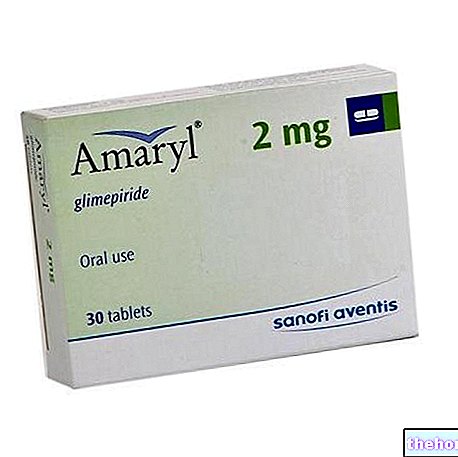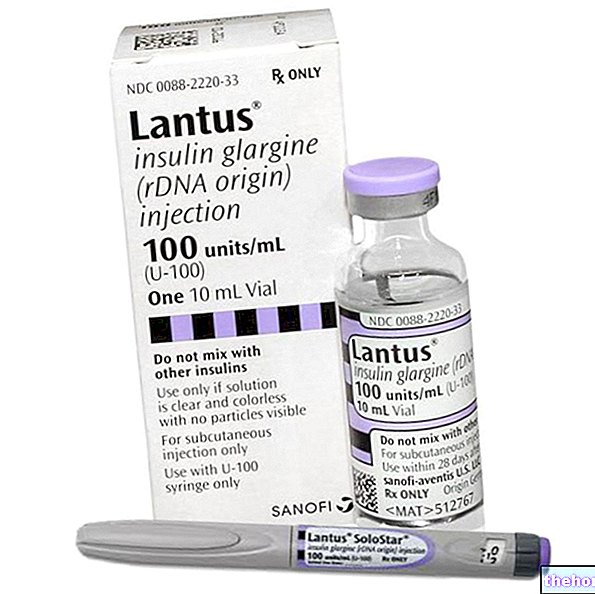Definition
Among the metabolic pathologies, diabetes plays a leading role, given the large number of patients affected; Type 1 diabetes mellitus is the result of an "alteration in metabolism triggered by poor functionality / availability of insulin, the hormone involved in regulating blood glucose levels. Type 1 diabetes mellitus (insulin-dependent ) and type 2 (insulin-independent).
Causes
Typical of the young age, type 1 diabetes mellitus is the consequence of an absolute insulin defect, therefore, this condition is defined as insulin-dependent; the insulin deficiency, in turn, is caused by a destruction of the beta cells of the pancreas (used for its synthesis), resulting from an autoimmune disease in which antibodies target their damaging action against the beta cells of the pancreas.
- An unbalanced, high-sugar diet and an incorrect lifestyle can contribute to accentuating diabetes.
Symptoms
The element that unites the various forms of diabetes is attributable to hyperglycemia, often associated with ketonemia, weight loss, intense hunger, overproduction of urine, nocturia, blurred vision, polyuria, thirst. Diabetes increases the risk of getting skin and urinary tract infections.
The information on Type 1 Diabetes - Drugs for the Treatment of Type 1 Diabetes is not intended to replace the direct relationship between health professional and patient. Always consult your doctor and / or specialist before taking Type 1 Diabetes - Drugs to Treat Type 1 Diabetes.
Medicines
Type 1 diabetes mellitus must be treated with drugs for life, starting from the moment it is diagnosed: diabetics must take insulin to guarantee the body a constant blood sugar, avoiding excessive glycemic peaks.
Pharmacological treatment aims to control the symptoms of diabetes and avoid serious complications, especially long-term ones.
The discovery of the subcutaneous administration of insulin for the treatment of diabetes was a great achievement for science, which made it possible to transform diabetes from a deadly disease (until the second decade of the twentieth century) into a manageable disease.
There are various forms of insulin, distinguished on the basis of latency time, peak time and duration of action.
Therapy aimed at treating the symptoms of type 1 diabetes mellitus involves the administration of insulin by subcutaneous injection; oral hypoglycemic agents, indicated for the treatment of type 2 diabetes mellitus, cannot be taken in the insulin-dependent form.
The following are the classes of drugs most used in the therapy against type 1 diabetes mellitus, and some examples of pharmacological specialties; it is up to the doctor to choose the most suitable active ingredient and dosage for the patient, based on the severity of the disease, the state of health of the patient and his response to treatment:
Drugs for the treatment of type 1 diabetes mellitus
- Ultra-fast acting insulin: Insulin Lispro (eg Humalog, Liprolog, Humalog Mix) and Insulin Aspart (eg Novorapid, Novomix). The action of the drug occurs 10-15 minutes after the injection; for this reason these insulins are used just before the meal for postprandial glycemic control. Inject the drug into the abdominal wall or thigh, being careful not to always administer the drug in the same place.
General guidelines for calculating the dose of drug (insulin) to be injected: multiply the body weight (kg) by 0.05 mg: you will get a value that must be rounded up to the whole number. For example, if you get a value of 2, 4 mg, should be considered equivalent to 2 (2 mg: dose to be injected).
- Fast-acting insulin (eg. Actrapid, Insulin human winthrop, Insuman Rapid): the action of the drug is expressed in about 30 minutes and disappears after 4-8 hours. It should be taken half an hour before a meal or when the blood sugar rises excessively. Inject the drug into the abdominal wall or thigh, respecting the dosages established by the doctor.
- Intermediate-acting insulin (eg Insuman Basal, Monotard): this type of insulin comes into action after a couple of hours, and the duration of action is guaranteed for 8-12 hours. Often times, it is combined with slow insulin to control blood glucose levels before lunch. This drug is also injected into the thigh or leg. The dosage and timing of administration must be determined by the doctor.
- Slow insulin: it comes into action after a couple of hours and covers almost the whole day (18-24 hours): the slowing down of the therapeutic action is made possible by the presence of zinc. Generally, only two injections are needed of slow insulin a day to ensure a constant level of blood sugar. In most cases, the drug is injected on the thigh, alternatively it is also possible to take the drug by injection on the abdomen, buttocks or shoulder. It is possible to take this insulin together with rapid insulin in conjunction with meals.
- Ultra-slow insulin (eg. Ultratard): as the word itself suggests, this type of insulin has a "delayed action" (thanks to zinc, which is able to slow down the therapeutic activity). A single injection of ultra-rapid insulin per day is sufficient to ensure its effect, although the diabetic patient often injects small doses of rapid insulin just before the start of the meal. The drug is available in 10 ml vials, containing 40 IU / ml of zinc insulin (human suspension). In general, to treat type 1 diabetes mellitus, it is recommended to inject a drug dose between 0.5 and 1 IU / kg. The exact dose must be determined by your doctor.
- Insulin glargine (eg. Lantus, Optisulin): just like the previous insulin, the action of this drug is ultra-slow, therefore only one injection per day is sufficient. It is possible to combine other types of insulins (rapid) shortly before The drug is available in 3 ml cartridges, 3 ml disposable pens and 10 ml bottles (all formulations contain 100 IU / ml of insulin glargine.) It is recommended to administer the drug at approximately the same time every time.
- Insulin and protamine (eg Protaphane): called “NpH” insulin (Neutral protamine Hagedorn), this drug acts in a similar way to slow insulin due to the presence of protamine which slows down its therapeutic action. An injection of insulin and protamine, repeated twice a day, is the general therapeutic indication for treating type 1 diabetes mellitus.
Correction of eating habits is essential to keep blood sugar under control; clearly, all foods rich in sugars (honey, sugar, biscuits, ice creams, sweets in general, chocolate, jam, carbonated and sugary drinks), dried fruit, fruit with a high sugar concentration (bananas, figs, persimmons, grapes, pomegranate). On the other hand, foods such as wholemeal pasta and rice, artificial sweeteners, vegetables, low-sugar fruit and light foods are included in the list of products that can be taken by patients with diabetes mellitus.
















.jpg)











